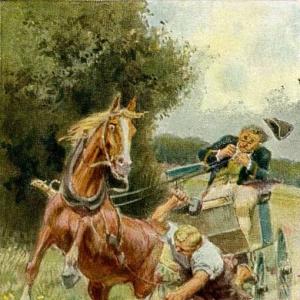Reading time: 11 min
Once there was a man who had written some new rhymes for the A-B-C Book – two lines for each letter, just as in the old A-B-C Book. He believed the old rhymes were too antiquated, that something new was needed, and he thought well indeed of his own rhymes.
His new A-B-C Book was still only in handwriting, and already it had been placed beside the old printed one in the great bookcase where there stood many books, both of knowledge and for amusement. But the old A-B-C Book didn’t want to be a neighbor to the new one, and therefore had sprung down from the shelf and at the same time had given the new one a push, so that it, as well as the old one, now lay on the floor, with all its loose leaves scattered about.
The old A-B-C Book lay open at the first page – and that is the most important page, for there all the letters, large and small, are displayed. That one page contains on it the essence of all the books that ever were written. It contains the alphabet, that wonderful army of signs which rules the world; truly a marvelous power they have! Everything depends on the order in which they are commanded to stand. They have the power to give life or to kill, to gladden and to sadden. Separately they mean nothing, but marshaled and ranked in word formations, what can they not accomplish! Yes, when God put them into man’s thoughts, human strength became inferior to that which lay in the alphabet, and we yielded with a deep bow.
There, then, they lay now, facing upward, and the Cock which was pictured at the big A of the alphabet gleamed with feathers of red, blue, and green. Proudly he puffed himself up and ruffled his plumage, for he knew how important the letters were and that he was the only living thing among them.
When he found the old A-B-C Book had fallen open on the floor, he flapped his wings, flew out, and perched himself on a corner of the bookcase. There he preened himself with his beak and crowed loudly and long. Every single book in the case, all of which would stand day and night, as if in a trance when nobody was reading them, was roused by his trumpet call. Then the Cock spoke out loudly and clearly about the way the worthy old A-B-C Book had been insulted.
„Everything has to be new and different nowadays,“ he said. „Everything has to be advanced. Children are so wise that they can read before they have even learned the alphabet. ‚They should have something new!‘ said the man who wrote those new verses sprawling there on the floor. I know them all by heart. He admires them so much that I have heard him read them aloud more than ten times over. No, I prefer my own, the good old rhymes with Xanthus for X, and with the pictures that belong to them! I’ll fight for them and crow for them! Every book in the case here knows them very well. Now I’ll read aloud these new rhymes. I’ll try to read them patiently, and I know we’ll all agree they’re worthless.
A – Adam
Had Adam obeyed, he’d not have had to leave
The Garden where first dwelt he and Eve. B – Bank; Bee
The Bank is a place where you put your money;
The Bee is an insect that gathers honey. „Now that verse I find profoundly insipid!“ said the Cock. „But I’ll read on.
C – Columbus
Columbus sailed the ocean to the distant shore,
And then the earth became twice as big as before. D – Denmark
About the kingdom of Denmark, there’s a saying which goes
God’s hand protects it, as every Dane knows. „That many people will consider beautiful,“ said the Cock. „But I don’t. I see nothing beautiful about it. But I’ll go on.
E – Elephant
The Elephant has a heavy step,
Though young in heart and full of pep. F – Face
The Moon above feels at its best
When an eclipse gives its Face a rest. G – Goat
It is easier to sail a boat
Than to teach manners to a Goat! H – Hurrah
Hurrah is a word we often hear;
How often does the deed merit such cheer? „How will a child understand that!“ said the Cock. „I suppose they’ll put on the title page, ‚A-B-C Book for Big People and Little People‘; but the big people have something else to do besides read the rhymes in A-B-C Books, and the little people won’t be able to understand them. There is a limit to everything. But to continue:
J – Job
We have a Job to do on earth
Till earth becomes our final berth. „Now, that’s crude!“ said the Cock.
K – Kitten
When Kittens grow up we call them cats
And hope they’ll catch our mice and rats. L – Lion
The savage Lion has much more sense
Than the arty critic’s stinging offense! „How are you going to explain that one to children?“ said the Cock.
M – Morning Sun
The golden Morning sun arose,
But not because of the cock’s crows. „Now he’s getting personal!“ said the Cock. „But then I’m in excellent company. I’m in company with the sun. Let’s go on.
N – Negro
Black is a Negro, black as Night,
And we cannot wash him white! O – Olive Leaf
The best of leaves – you know its name? The dove’s Olive leaf – of Bible fame. P – Peace
That Peace may ever reign, far and near,
Is indeed a hope we all hold dear. Q – Queen; Quack
A Queen is a lady of royal position. A Quack is a fake and not a physician. R – Round
One may be Round and well extended,
But that doesn’t mean one is well descended! S – Swine
Be not a braggart; be honest and true,
Though many Swine in the forest belong to you! „Will you permit me to crow!“ said the Cock. „It tries your strength, reading so much. I must catch my breath.“ And then he crowed, shrill as a trumpet of brass, and it was a great pleasure to listen to – for the Cock. „I’ll go on.
T – Teakettle; Tea Urn
The Teakettle in the kitchen will always belong,
And yet to the Tea urn it gives its song. U – Universe
Our Universe will always be,
Through ages to eternity. „Now that is meant to be deep!“ said the Cock. „It’s so deep I can’t get to the bottom of it!
W – Washerwoman
A Washerwoman will wash and scrub
Until there’s nothing left but the tub! „Now, it’s certainly impossible that he can have found anything new for X.
X – Xantippe
In the sea of marriage are rocks of strife,
As Socrates found with Xantippe, his wife. „He would have to take Xantippe! Xanthus is much better.
Y – Ygdrasil
Under Ygdrasil tree the gods sat every day;
But the tree is dead and the gods have gone away. „Now we are almost through,“ said the Cock. „That’s a relief. I’ll continue on.
Z – Zephyr
Zephyr, in Danish, is a west wind so cold
It penetrates fur and skin, we’re told. „That’s that. But that’s not the end of it. Now it will be printed and then it will be read. It will be offered in place of the noble old rhymes in my book. What says this assembly – learned and not so learned, single volumes and collected works? What says the alphabet? I have spoken. Now let the others act.“
The books stood still, and the bookcase stood still; but the Cock flew back to his place at the capital A in the old A-B-C Book and looked proudly around. „I have spoken well, and I have crowed well. The new A-B-C Book can’t do anything like that. It will certainly die. In fact, it’s dead already, for it has no Cock!“
 Learn languages. Double-tap on a word.Learn languages in context with Childstories.org and Deepl.com.
Learn languages. Double-tap on a word.Learn languages in context with Childstories.org and Deepl.com.Backgrounds
Interpretations
Adaptions
Summary
Linguistics
„The A-B-C book“ is a fairy tale written by Danish author Hans Christian Andersen. Born on April 2, 1805, and passing away on August 4, 1875, Andersen was a prolific writer known for his fairy tales, which have been translated into numerous languages and have become an integral part of global children’s literature. Some of his most famous works include „The Little Mermaid,“ „The Ugly Duckling,“ „The Emperor’s New Clothes,“ and „The Snow Queen.“
Andersen’s fairy tales often contain moral lessons and explore themes such as love, friendship, bravery, and the struggle between good and evil. His stories typically feature elements of fantasy and magic, which serve to enchant and captivate readers of all ages.
In „The A-B-C book,“ Andersen uses the conflict between the old and new A-B-C Books to explore themes such as tradition versus innovation, the power of language, and the role of children’s literature in education. The tale serves as a reminder of the importance of preserving traditions while also being open to new ideas and the potential impact that language can have on society and individuals.
While „The A-B-C book“ may not be as widely known as some of Andersen’s other fairy tales, it showcases his ability to create imaginative stories that offer meaningful lessons and insights.
„The A-B-C book“ by Hans Christian Andersen can be interpreted in various ways, touching on themes such as tradition versus innovation, the power of language, and the role of children’s literature in education.
Tradition vs. Innovation: The story presents the conflict between the old A-B-C Book, representing tradition, and the new A-B-C Book, representing innovation. The cock fiercely defends the old rhymes, believing that they hold value and should not be replaced by the new rhymes. This can be seen as a commentary on the struggle between maintaining traditions and embracing change or new ideas in society.
The Power of Language: The tale emphasizes the importance and power of language through the alphabet. The cock acknowledges the incredible potential of the alphabet to shape the world, depending on how the letters are arranged. This theme serves as a reminder of the responsibility that comes with creating and using language, as it can have profound effects on individuals and society.
Role of Children’s Literature in Education: The story raises questions about the appropriateness and effectiveness of children’s literature in education. The cock criticizes the new A-B-C Book’s rhymes for being too complex or unsuitable for children, suggesting that educational materials should be tailored to their target audience. This highlights the importance of creating content that is age-appropriate and accessible for children, ensuring that they can learn and grow from it.
Pride and Self-Importance: The cock’s pride and self-importance are also evident throughout the story. He takes it upon himself to defend the old A-B-C Book and criticize the new one, believing that his opinions hold great value. This can serve as a reminder that pride and self-importance can sometimes cloud one’s judgment and that it is essential to remain open to differing perspectives and ideas.
In conclusion, „The A-B-C book“ by Hans Christian Andersen offers various interpretations, touching on themes such as tradition, the power of language, the role of children’s literature in education, and the influence of pride and self-importance on one’s judgment.
Hans Christian Andersen’s „The A-B-C Book“ has inspired several adaptations in different media. Here are some notable examples.
The ABC Book: A Musical Game for Children (1857): This is a musical adaptation of the story by composer Stephen Glover. It features songs for each letter of the alphabet, and was designed to be used as an educational tool to teach children the alphabet.
The ABC Book: A Pop-Up Alphabet (1986): This is a children’s book adaptation of the story by Robert Sabuda. It features elaborate pop-up illustrations for each letter of the alphabet, and is designed to be a playful and interactive way for children to learn the alphabet.
The A-B-C Murders (1936): This is a detective novel by Agatha Christie that uses the letters of the alphabet as a motif. The plot revolves around a series of murders that are committed in alphabetical order, and the detective must solve the mystery before the killer completes the alphabet.
The ABCs of Death (2012): This is a horror anthology film that features 26 short films, each based on a different letter of the alphabet. The film is not directly based on Andersen’s story, but it uses the alphabet as a structure to explore different themes of horror and death.
Sesame Street: This popular children’s TV show often features segments that teach children the alphabet and basic words, using playful and interactive methods. These segments are indirectly influenced by Andersen’s story, which also aims to teach children the alphabet in a playful and imaginative way.
Overall, „The A-B-C Book“ has inspired several adaptations in different genres, demonstrating its enduring appeal as a story that explores the themes of education, imagination, and self-discovery.
„The A-B-C book“ by Hans Christian Andersen is a fairy tale that revolves around an old A-B-C Book and a new A-B-C Book created by a man who believes that the old rhymes are outdated. The old A-B-C Book takes offense at being placed next to the new one, and they both end up falling off the bookshelf. The old A-B-C Book opens to the first page, which contains the alphabet and a picture of a cock, the only living thing among the letters.
The cock, aware of the importance of the alphabet, flies out of the book and perches on a corner of the bookcase. From there, he speaks out against the new A-B-C Book, calling its rhymes worthless and inappropriate for children. He reads aloud each rhyme for the letters, critiquing them for being insipid, crude, or too complex for children to understand.
The cock crows proudly after finishing the new rhymes, stating that the new A-B-C Book will die because it lacks the charm and history of the old one. He returns to his place at the capital A in the old A-B-C Book and looks around proudly, convinced that the new A-B-C Book will never replace the old one.
In the fairy tale „The A-B-C Book“ by Hans Christian Andersen, a humorous and insightful narrative unfolds through the personification of books in a library. The story presents both a critique of the modern inclination toward novelty for its own sake and an exploration of the timeless power of the alphabet. Let’s delve into a linguistic analysis of the story.
Personification and Symbolism
Andersen uses personification extensively to make abstract concepts more tangible. The old A-B-C Book represents traditional values and tried-and-tested knowledge, while the new A-B-C Book symbolizes modern innovation and change, often criticized for lacking substance. The Cock, a symbol of vigilance and pride, acts as a guardian of tradition, taking on the role of critic when reading the new verses.
Commentary on Language and Literature
The story reflects on the potency of language through the alphabet: „the wonderful army of signs which rules the world. “ This idea underscores how language is foundational to human civilization, able to inspire, inform, and influence profoundly. The narrative implies that while new ideas can refresh literature, they must also respect the elemental power of well-established linguistic constructs.
Humorous Critique
The Cock’s critique of the new verses serves to provide humor and wit. Lines such as „It is easier to sail a boat / Than to teach manners to a Goat!“ are dismissed as nonsensical and overly complex, especially for an A-B-C Book. This critique highlights Andersen’s skepticism about replacing traditional educational materials with newer, yet less effective, content.
Contrast Between Old and New
The tale contrasts the old, reliable rhymes with the new, attempting-to-be-profound verses. Andersen suggests that sophistication doesn’t necessarily equate to improvement. The critique of the new verses, such as finding them „profoundly insipid,“ underscores the enduring value of simplicity and clarity, especially in educational contexts.
Cultural References and Complexity
The new A-B-C Book includes references that may be too intricate for its intended young audience, such as Xantippe and Ygdrasil. This mirrors Andersen’s concern that modern works sometimes prioritize cleverness over accessibility, alienating their audience instead of engaging them.
Meta-Narrative
Andersen’s story reflects a broader meta-narrative about the evolution of literature and education. The books and the Cock embody different perspectives within this discourse, with the Cock’s pride and advocacy for the old book offering a comforting notion about the durability of traditional wisdom amidst the ever-changing tides of new ideas.
Conclusion
Overall, „The A-B-C Book“ offers a critical yet humorous take on the balance between tradition and innovation within literature and education. Through linguistic play, personification, and satire, Andersen encourages readers to appreciate the timelessness of the alphabet and to be discerning about the values of new literary endeavors.
Information for scientific analysis
Fairy tale statistics | Value |
|---|---|
| Translations | DE, EN, DA, ES |
| Readability Index by Björnsson | 22.4 |
| Flesch-Reading-Ease Index | 88 |
| Flesch–Kincaid Grade-Level | 3.6 |
| Gunning Fog Index | 6.3 |
| Coleman–Liau Index | 7.4 |
| SMOG Index | 7.9 |
| Automated Readability Index | 2.4 |
| Character Count | 7.148 |
| Letter Count | 5.341 |
| Sentence Count | 128 |
| Word Count | 1.355 |
| Average Words per Sentence | 10,59 |
| Words with more than 6 letters | 160 |
| Percentage of long words | 11.8% |
| Number of Syllables | 1.732 |
| Average Syllables per Word | 1,28 |
| Words with three Syllables | 84 |
| Percentage Words with three Syllables | 6.2% |

 Facebook
Facebook  Whatsapp
Whatsapp  Messenger
Messenger  Telegram
Telegram Reddit
Reddit













